Management & Operation Introduction 1
VerifiedAdded on 2021/02/18
|19
|5788
|386
AI Summary
It will investigate leadership traits theory and two style of leadership as well as analysis of Hard and Soft management skills in the company. Furthermore, assignment will discuss three transformation process in operation management and evaluate of meaning of quality and four costs of quality for managers in achieve gaols of firm. Leadership is the direction of practice of business to make large level of efficiency possible within company.
Contribute Materials
Your contribution can guide someone’s learning journey. Share your
documents today.
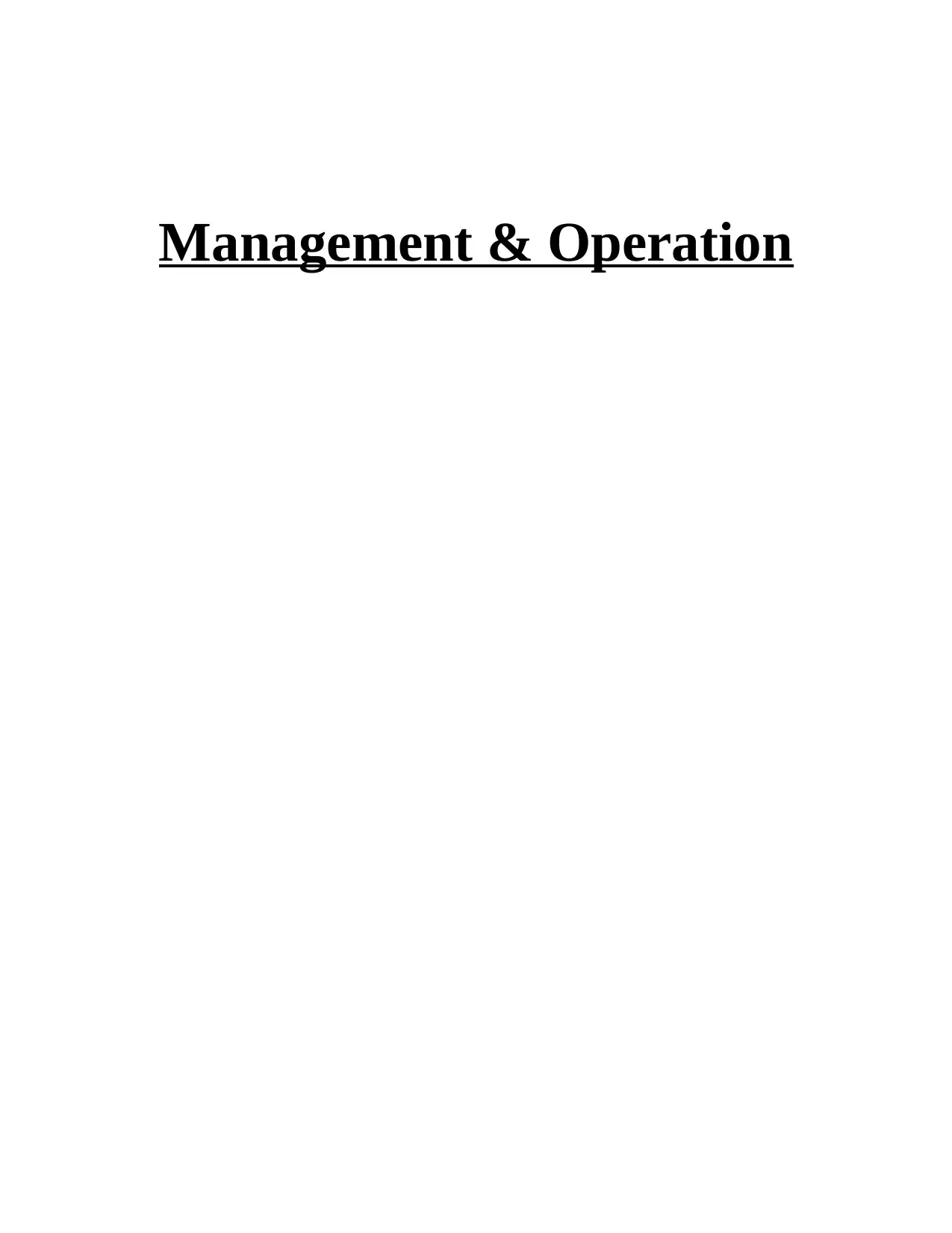
Management & Operation
Secure Best Marks with AI Grader
Need help grading? Try our AI Grader for instant feedback on your assignments.
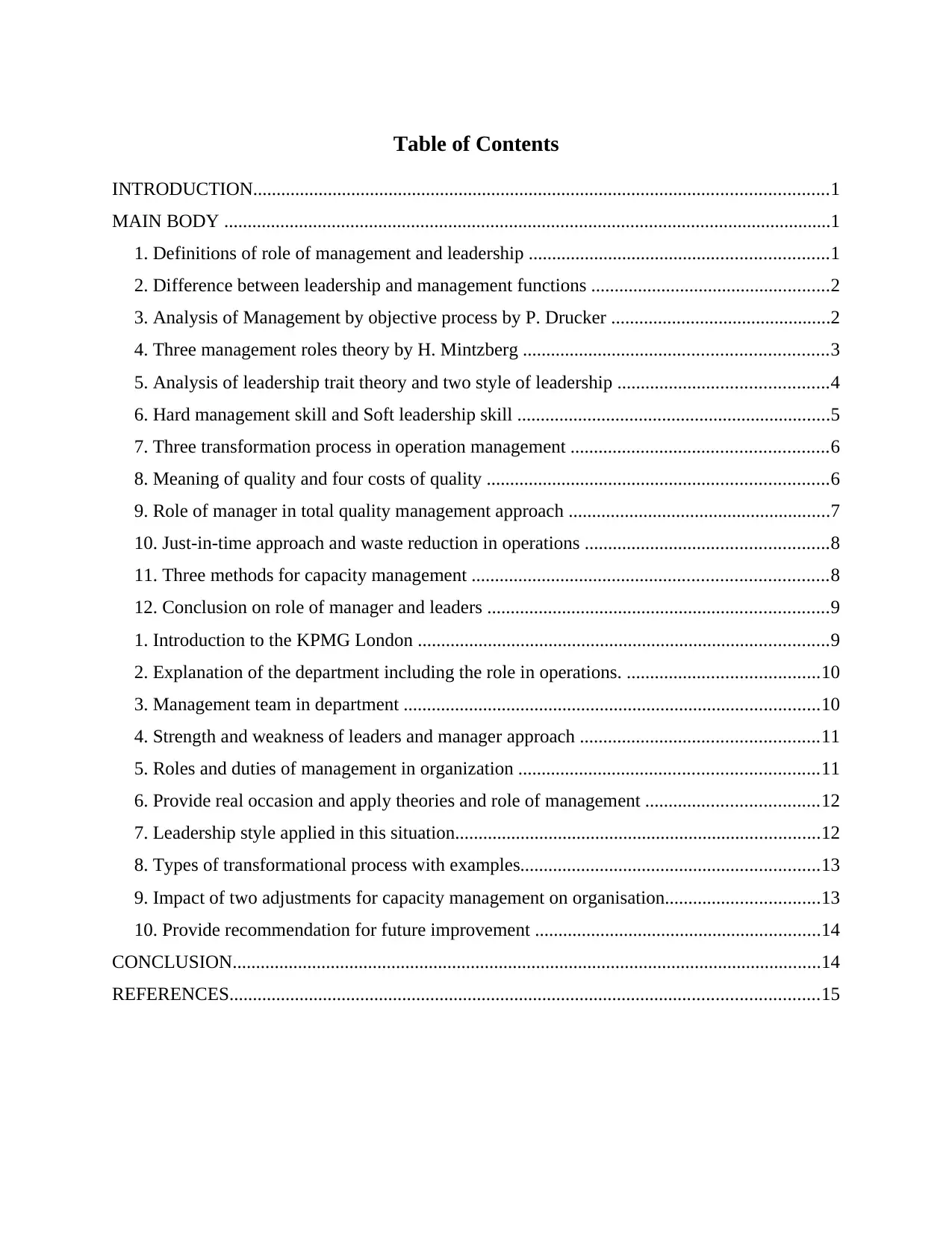
Table of Contents
INTRODUCTION...........................................................................................................................1
MAIN BODY ..................................................................................................................................1
1. Definitions of role of management and leadership ................................................................1
2. Difference between leadership and management functions ...................................................2
3. Analysis of Management by objective process by P. Drucker ...............................................2
4. Three management roles theory by H. Mintzberg .................................................................3
5. Analysis of leadership trait theory and two style of leadership .............................................4
6. Hard management skill and Soft leadership skill ...................................................................5
7. Three transformation process in operation management .......................................................6
8. Meaning of quality and four costs of quality .........................................................................6
9. Role of manager in total quality management approach ........................................................7
10. Just-in-time approach and waste reduction in operations ....................................................8
11. Three methods for capacity management ............................................................................8
12. Conclusion on role of manager and leaders .........................................................................9
1. Introduction to the KPMG London ........................................................................................9
2. Explanation of the department including the role in operations. .........................................10
3. Management team in department .........................................................................................10
4. Strength and weakness of leaders and manager approach ...................................................11
5. Roles and duties of management in organization ................................................................11
6. Provide real occasion and apply theories and role of management .....................................12
7. Leadership style applied in this situation..............................................................................12
8. Types of transformational process with examples................................................................13
9. Impact of two adjustments for capacity management on organisation.................................13
10. Provide recommendation for future improvement .............................................................14
CONCLUSION..............................................................................................................................14
REFERENCES..............................................................................................................................15
INTRODUCTION...........................................................................................................................1
MAIN BODY ..................................................................................................................................1
1. Definitions of role of management and leadership ................................................................1
2. Difference between leadership and management functions ...................................................2
3. Analysis of Management by objective process by P. Drucker ...............................................2
4. Three management roles theory by H. Mintzberg .................................................................3
5. Analysis of leadership trait theory and two style of leadership .............................................4
6. Hard management skill and Soft leadership skill ...................................................................5
7. Three transformation process in operation management .......................................................6
8. Meaning of quality and four costs of quality .........................................................................6
9. Role of manager in total quality management approach ........................................................7
10. Just-in-time approach and waste reduction in operations ....................................................8
11. Three methods for capacity management ............................................................................8
12. Conclusion on role of manager and leaders .........................................................................9
1. Introduction to the KPMG London ........................................................................................9
2. Explanation of the department including the role in operations. .........................................10
3. Management team in department .........................................................................................10
4. Strength and weakness of leaders and manager approach ...................................................11
5. Roles and duties of management in organization ................................................................11
6. Provide real occasion and apply theories and role of management .....................................12
7. Leadership style applied in this situation..............................................................................12
8. Types of transformational process with examples................................................................13
9. Impact of two adjustments for capacity management on organisation.................................13
10. Provide recommendation for future improvement .............................................................14
CONCLUSION..............................................................................................................................14
REFERENCES..............................................................................................................................15

INTRODUCTION
Management is the direction of the company which involves setting of strategy,
coordinating efforts of employees to achieve gaols of organization through apply the available
resource like financial, natural, human resources and technological resources. On other side,
operation is activity of functioning or fact of being active and its effect (Strande and Brdjanovic,
eds., 2014). Operation management is the direction of practice of business to make large level of
efficiency possible within company. It is also concerned with changing materials and labour into
products and services to maximize the profits of company. This study is based on KPMG. It is
the professional service company and one of the Big Four auditors along with Deloitte,
Ernst&Young and Price water house Coopers (PwC).
Report will introduce definitions of roles of management and leadership, difference
between leadership and management functions within the organization. It will analysis of
management by objectives process and three management roles theory in the firm. It will
investigate leadership traits theory and two style of leadership as well as analysis of Hard and
Soft management skills in the company. Furthermore, assignment will discuss three
transformation process in operation management and evaluate of meaning of quality and four
costs of quality for managers in achieve gaols of firm.
MAIN BODY
1. Definitions of role of management and leadership
Leadership:
It is setting new vision or direction for team which they follow. Leadership is the
procedure by which supervisor can direct, guide and effect the behaviour as well as work of
other towards achievement of particular objectives in given situations (Bahmani-Firouzi and
Azizipanah-Abarghooee, 2014). It is the ability of leaders to induce followers to perform with
confidence. Leadership role defined as sets of clear vision, motivates and guide employee
through work process and build their morale.
Management:
It is the procedure of reaching goals of company through working with people and other
resources of firm. In this context, manager plays various and essential roles in the firm such as
interpersonal, informational and decisional role within the organization. Managers plays role in
Management is the direction of the company which involves setting of strategy,
coordinating efforts of employees to achieve gaols of organization through apply the available
resource like financial, natural, human resources and technological resources. On other side,
operation is activity of functioning or fact of being active and its effect (Strande and Brdjanovic,
eds., 2014). Operation management is the direction of practice of business to make large level of
efficiency possible within company. It is also concerned with changing materials and labour into
products and services to maximize the profits of company. This study is based on KPMG. It is
the professional service company and one of the Big Four auditors along with Deloitte,
Ernst&Young and Price water house Coopers (PwC).
Report will introduce definitions of roles of management and leadership, difference
between leadership and management functions within the organization. It will analysis of
management by objectives process and three management roles theory in the firm. It will
investigate leadership traits theory and two style of leadership as well as analysis of Hard and
Soft management skills in the company. Furthermore, assignment will discuss three
transformation process in operation management and evaluate of meaning of quality and four
costs of quality for managers in achieve gaols of firm.
MAIN BODY
1. Definitions of role of management and leadership
Leadership:
It is setting new vision or direction for team which they follow. Leadership is the
procedure by which supervisor can direct, guide and effect the behaviour as well as work of
other towards achievement of particular objectives in given situations (Bahmani-Firouzi and
Azizipanah-Abarghooee, 2014). It is the ability of leaders to induce followers to perform with
confidence. Leadership role defined as sets of clear vision, motivates and guide employee
through work process and build their morale.
Management:
It is the procedure of reaching goals of company through working with people and other
resources of firm. In this context, manager plays various and essential roles in the firm such as
interpersonal, informational and decisional role within the organization. Managers plays role in
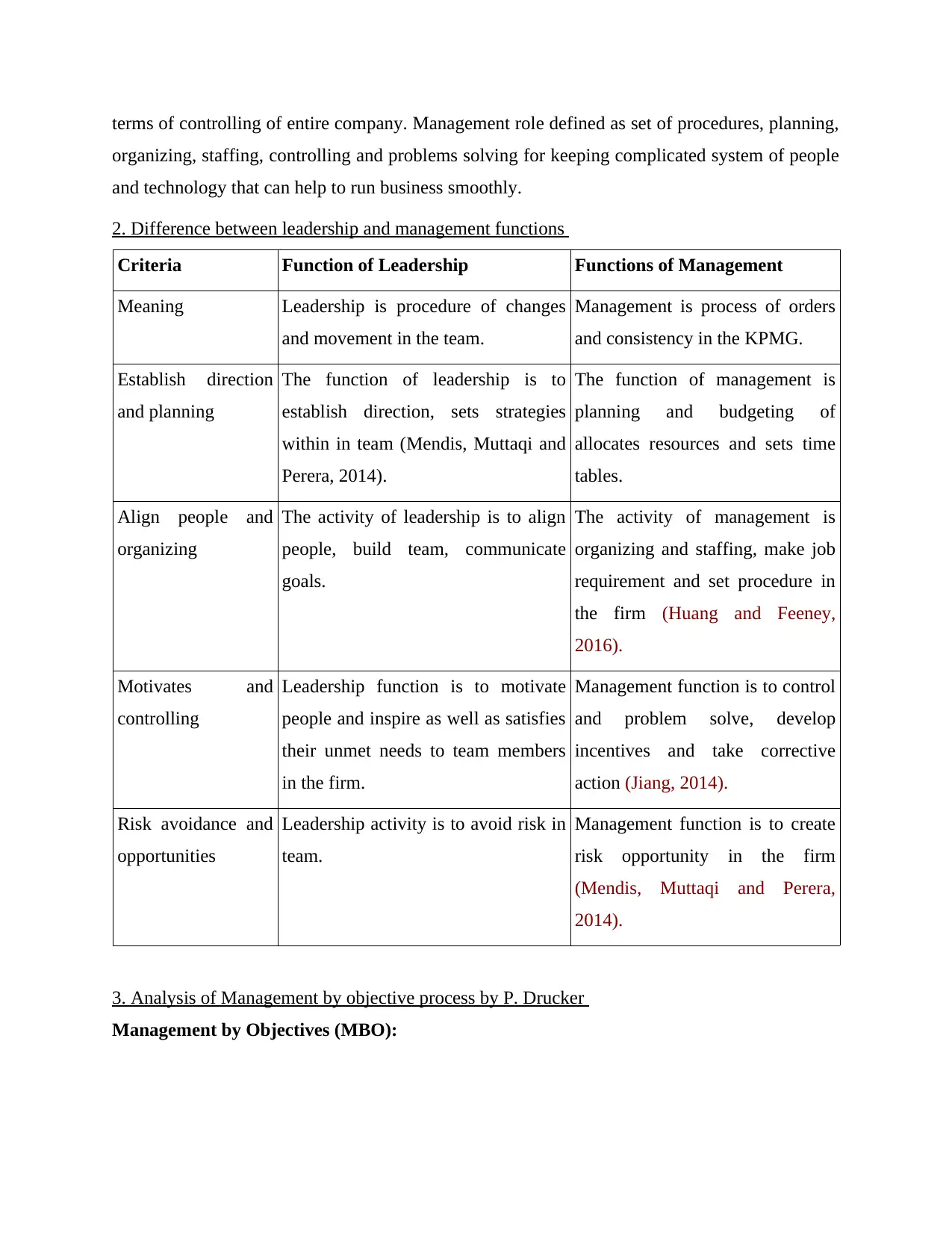
terms of controlling of entire company. Management role defined as set of procedures, planning,
organizing, staffing, controlling and problems solving for keeping complicated system of people
and technology that can help to run business smoothly.
2. Difference between leadership and management functions
Criteria Function of Leadership Functions of Management
Meaning Leadership is procedure of changes
and movement in the team.
Management is process of orders
and consistency in the KPMG.
Establish direction
and planning
The function of leadership is to
establish direction, sets strategies
within in team (Mendis, Muttaqi and
Perera, 2014).
The function of management is
planning and budgeting of
allocates resources and sets time
tables.
Align people and
organizing
The activity of leadership is to align
people, build team, communicate
goals.
The activity of management is
organizing and staffing, make job
requirement and set procedure in
the firm (Huang and Feeney,
2016).
Motivates and
controlling
Leadership function is to motivate
people and inspire as well as satisfies
their unmet needs to team members
in the firm.
Management function is to control
and problem solve, develop
incentives and take corrective
action (Jiang, 2014).
Risk avoidance and
opportunities
Leadership activity is to avoid risk in
team.
Management function is to create
risk opportunity in the firm
(Mendis, Muttaqi and Perera,
2014).
3. Analysis of Management by objective process by P. Drucker
Management by Objectives (MBO):
organizing, staffing, controlling and problems solving for keeping complicated system of people
and technology that can help to run business smoothly.
2. Difference between leadership and management functions
Criteria Function of Leadership Functions of Management
Meaning Leadership is procedure of changes
and movement in the team.
Management is process of orders
and consistency in the KPMG.
Establish direction
and planning
The function of leadership is to
establish direction, sets strategies
within in team (Mendis, Muttaqi and
Perera, 2014).
The function of management is
planning and budgeting of
allocates resources and sets time
tables.
Align people and
organizing
The activity of leadership is to align
people, build team, communicate
goals.
The activity of management is
organizing and staffing, make job
requirement and set procedure in
the firm (Huang and Feeney,
2016).
Motivates and
controlling
Leadership function is to motivate
people and inspire as well as satisfies
their unmet needs to team members
in the firm.
Management function is to control
and problem solve, develop
incentives and take corrective
action (Jiang, 2014).
Risk avoidance and
opportunities
Leadership activity is to avoid risk in
team.
Management function is to create
risk opportunity in the firm
(Mendis, Muttaqi and Perera,
2014).
3. Analysis of Management by objective process by P. Drucker
Management by Objectives (MBO):
Secure Best Marks with AI Grader
Need help grading? Try our AI Grader for instant feedback on your assignments.
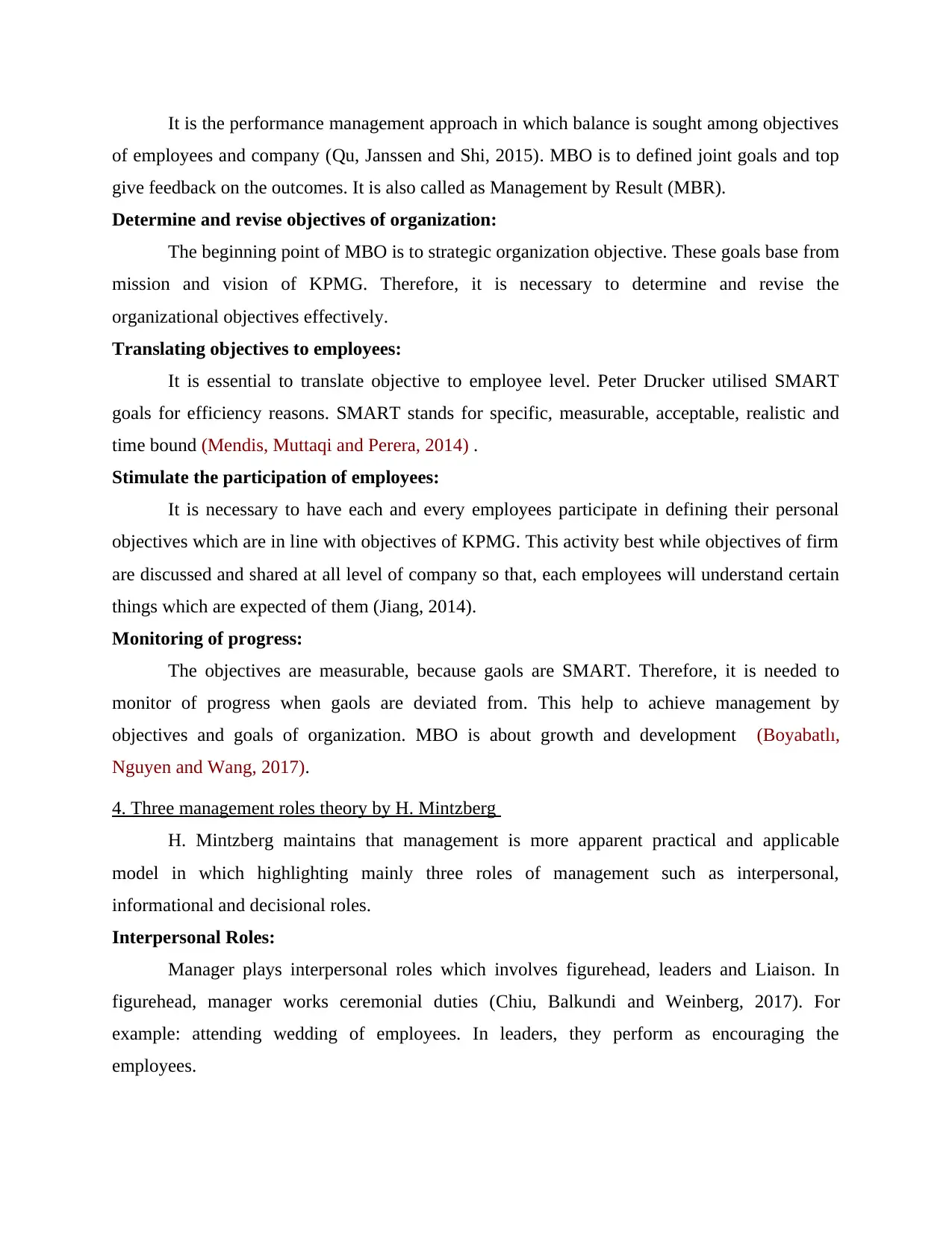
It is the performance management approach in which balance is sought among objectives
of employees and company (Qu, Janssen and Shi, 2015). MBO is to defined joint goals and top
give feedback on the outcomes. It is also called as Management by Result (MBR).
Determine and revise objectives of organization:
The beginning point of MBO is to strategic organization objective. These goals base from
mission and vision of KPMG. Therefore, it is necessary to determine and revise the
organizational objectives effectively.
Translating objectives to employees:
It is essential to translate objective to employee level. Peter Drucker utilised SMART
goals for efficiency reasons. SMART stands for specific, measurable, acceptable, realistic and
time bound (Mendis, Muttaqi and Perera, 2014) .
Stimulate the participation of employees:
It is necessary to have each and every employees participate in defining their personal
objectives which are in line with objectives of KPMG. This activity best while objectives of firm
are discussed and shared at all level of company so that, each employees will understand certain
things which are expected of them (Jiang, 2014).
Monitoring of progress:
The objectives are measurable, because gaols are SMART. Therefore, it is needed to
monitor of progress when gaols are deviated from. This help to achieve management by
objectives and goals of organization. MBO is about growth and development (Boyabatlı,
Nguyen and Wang, 2017).
4. Three management roles theory by H. Mintzberg
H. Mintzberg maintains that management is more apparent practical and applicable
model in which highlighting mainly three roles of management such as interpersonal,
informational and decisional roles.
Interpersonal Roles:
Manager plays interpersonal roles which involves figurehead, leaders and Liaison. In
figurehead, manager works ceremonial duties (Chiu, Balkundi and Weinberg, 2017). For
example: attending wedding of employees. In leaders, they perform as encouraging the
employees.
of employees and company (Qu, Janssen and Shi, 2015). MBO is to defined joint goals and top
give feedback on the outcomes. It is also called as Management by Result (MBR).
Determine and revise objectives of organization:
The beginning point of MBO is to strategic organization objective. These goals base from
mission and vision of KPMG. Therefore, it is necessary to determine and revise the
organizational objectives effectively.
Translating objectives to employees:
It is essential to translate objective to employee level. Peter Drucker utilised SMART
goals for efficiency reasons. SMART stands for specific, measurable, acceptable, realistic and
time bound (Mendis, Muttaqi and Perera, 2014) .
Stimulate the participation of employees:
It is necessary to have each and every employees participate in defining their personal
objectives which are in line with objectives of KPMG. This activity best while objectives of firm
are discussed and shared at all level of company so that, each employees will understand certain
things which are expected of them (Jiang, 2014).
Monitoring of progress:
The objectives are measurable, because gaols are SMART. Therefore, it is needed to
monitor of progress when gaols are deviated from. This help to achieve management by
objectives and goals of organization. MBO is about growth and development (Boyabatlı,
Nguyen and Wang, 2017).
4. Three management roles theory by H. Mintzberg
H. Mintzberg maintains that management is more apparent practical and applicable
model in which highlighting mainly three roles of management such as interpersonal,
informational and decisional roles.
Interpersonal Roles:
Manager plays interpersonal roles which involves figurehead, leaders and Liaison. In
figurehead, manager works ceremonial duties (Chiu, Balkundi and Weinberg, 2017). For
example: attending wedding of employees. In leaders, they perform as encouraging the
employees.
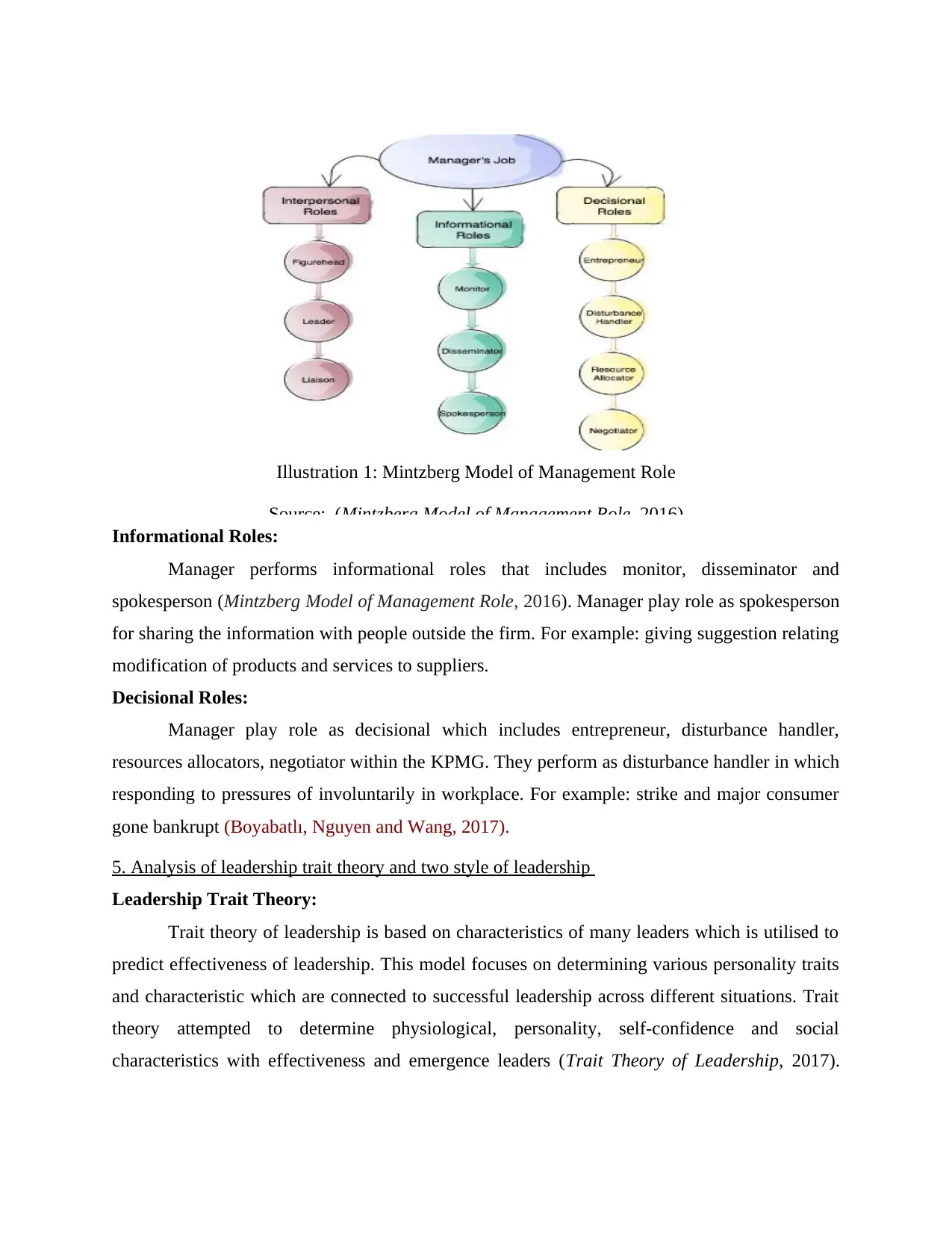
Informational Roles:
Manager performs informational roles that includes monitor, disseminator and
spokesperson (Mintzberg Model of Management Role, 2016). Manager play role as spokesperson
for sharing the information with people outside the firm. For example: giving suggestion relating
modification of products and services to suppliers.
Decisional Roles:
Manager play role as decisional which includes entrepreneur, disturbance handler,
resources allocators, negotiator within the KPMG. They perform as disturbance handler in which
responding to pressures of involuntarily in workplace. For example: strike and major consumer
gone bankrupt (Boyabatlı, Nguyen and Wang, 2017).
5. Analysis of leadership trait theory and two style of leadership
Leadership Trait Theory:
Trait theory of leadership is based on characteristics of many leaders which is utilised to
predict effectiveness of leadership. This model focuses on determining various personality traits
and characteristic which are connected to successful leadership across different situations. Trait
theory attempted to determine physiological, personality, self-confidence and social
characteristics with effectiveness and emergence leaders (Trait Theory of Leadership, 2017).
Illustration 1: Mintzberg Model of Management Role
Source: (Mintzberg Model of Management Role. 2016)
Manager performs informational roles that includes monitor, disseminator and
spokesperson (Mintzberg Model of Management Role, 2016). Manager play role as spokesperson
for sharing the information with people outside the firm. For example: giving suggestion relating
modification of products and services to suppliers.
Decisional Roles:
Manager play role as decisional which includes entrepreneur, disturbance handler,
resources allocators, negotiator within the KPMG. They perform as disturbance handler in which
responding to pressures of involuntarily in workplace. For example: strike and major consumer
gone bankrupt (Boyabatlı, Nguyen and Wang, 2017).
5. Analysis of leadership trait theory and two style of leadership
Leadership Trait Theory:
Trait theory of leadership is based on characteristics of many leaders which is utilised to
predict effectiveness of leadership. This model focuses on determining various personality traits
and characteristic which are connected to successful leadership across different situations. Trait
theory attempted to determine physiological, personality, self-confidence and social
characteristics with effectiveness and emergence leaders (Trait Theory of Leadership, 2017).
Illustration 1: Mintzberg Model of Management Role
Source: (Mintzberg Model of Management Role. 2016)
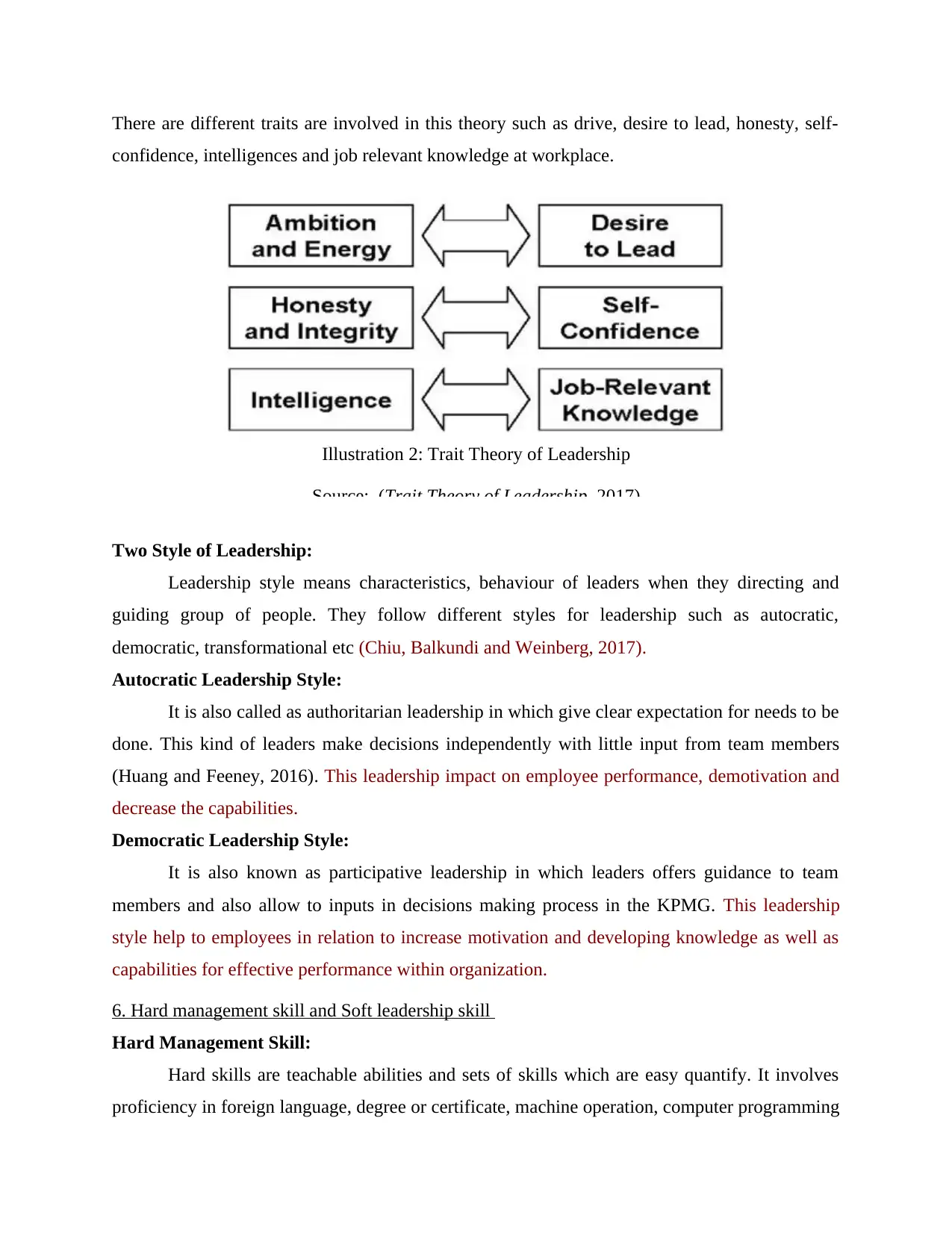
There are different traits are involved in this theory such as drive, desire to lead, honesty, self-
confidence, intelligences and job relevant knowledge at workplace.
Two Style of Leadership:
Leadership style means characteristics, behaviour of leaders when they directing and
guiding group of people. They follow different styles for leadership such as autocratic,
democratic, transformational etc (Chiu, Balkundi and Weinberg, 2017).
Autocratic Leadership Style:
It is also called as authoritarian leadership in which give clear expectation for needs to be
done. This kind of leaders make decisions independently with little input from team members
(Huang and Feeney, 2016). This leadership impact on employee performance, demotivation and
decrease the capabilities.
Democratic Leadership Style:
It is also known as participative leadership in which leaders offers guidance to team
members and also allow to inputs in decisions making process in the KPMG. This leadership
style help to employees in relation to increase motivation and developing knowledge as well as
capabilities for effective performance within organization.
6. Hard management skill and Soft leadership skill
Hard Management Skill:
Hard skills are teachable abilities and sets of skills which are easy quantify. It involves
proficiency in foreign language, degree or certificate, machine operation, computer programming
Illustration 2: Trait Theory of Leadership
Source: (Trait Theory of Leadership. 2017)
confidence, intelligences and job relevant knowledge at workplace.
Two Style of Leadership:
Leadership style means characteristics, behaviour of leaders when they directing and
guiding group of people. They follow different styles for leadership such as autocratic,
democratic, transformational etc (Chiu, Balkundi and Weinberg, 2017).
Autocratic Leadership Style:
It is also called as authoritarian leadership in which give clear expectation for needs to be
done. This kind of leaders make decisions independently with little input from team members
(Huang and Feeney, 2016). This leadership impact on employee performance, demotivation and
decrease the capabilities.
Democratic Leadership Style:
It is also known as participative leadership in which leaders offers guidance to team
members and also allow to inputs in decisions making process in the KPMG. This leadership
style help to employees in relation to increase motivation and developing knowledge as well as
capabilities for effective performance within organization.
6. Hard management skill and Soft leadership skill
Hard Management Skill:
Hard skills are teachable abilities and sets of skills which are easy quantify. It involves
proficiency in foreign language, degree or certificate, machine operation, computer programming
Illustration 2: Trait Theory of Leadership
Source: (Trait Theory of Leadership. 2017)
Paraphrase This Document
Need a fresh take? Get an instant paraphrase of this document with our AI Paraphraser

etc (Amanchukwu, Stanley and Ololube, 2015). These hard skills are listed in cover letter and
resume, so that manager is easy recruiting and selecting the people in the KPMG. For example: if
any kind of problem can happen in computer, so that manager easily solve this issue with
computer programming skills.
Soft Leadership Skill:
Soft skills are subjective abilities which are harder to measure. It is also called as people
and interpersonal skills. These abilities are related to way of interaction to people. It involves
communication, flexibility, leadership, motivation, team work, time management etc
(Nanjundeswaraswamy and Swamy, 2014). For example: there is conflict occurs between team
members, so that leaders easy communicate with them and resolving conflicts between them.
These skills help to achieve the objectives of team and organization.
7. Three transformation process in operation management
Transformation process is activity that takes one or more inputs, transforms and adds
values them and gives outputs for clients. There are different types of transformation process to
inputs into outputs such as: manufacture, supply, services and transport.
Manufacturing Transformation Process:
The physical creating of products is called as manufacturing transformation process.
Manufacturing transformation process involves rethinking strategies and planning, services
imperative, innovation for producing the goods and services within the firm. For example: cars
Transport Transformation Process:
The movement of material or consumers is known as transport transformation process. In
this process, firm used various materials and resources for providing the services to customers.
For example: taxi services (Saeed and eta.l., 2014).
Supply Transformation Process:
The modification in ownership of goods is called as supply transformation process. It
involves marketing, distribution and purchasing for providing goods to right consumers. For
example: retail business. For transform supply chain, firm needs to determine the supply chain
scope, changes in culture, integrate decision making with consumers and develop strategy of
supple chain of business.
8. Meaning of quality and four costs of quality
Quality:
resume, so that manager is easy recruiting and selecting the people in the KPMG. For example: if
any kind of problem can happen in computer, so that manager easily solve this issue with
computer programming skills.
Soft Leadership Skill:
Soft skills are subjective abilities which are harder to measure. It is also called as people
and interpersonal skills. These abilities are related to way of interaction to people. It involves
communication, flexibility, leadership, motivation, team work, time management etc
(Nanjundeswaraswamy and Swamy, 2014). For example: there is conflict occurs between team
members, so that leaders easy communicate with them and resolving conflicts between them.
These skills help to achieve the objectives of team and organization.
7. Three transformation process in operation management
Transformation process is activity that takes one or more inputs, transforms and adds
values them and gives outputs for clients. There are different types of transformation process to
inputs into outputs such as: manufacture, supply, services and transport.
Manufacturing Transformation Process:
The physical creating of products is called as manufacturing transformation process.
Manufacturing transformation process involves rethinking strategies and planning, services
imperative, innovation for producing the goods and services within the firm. For example: cars
Transport Transformation Process:
The movement of material or consumers is known as transport transformation process. In
this process, firm used various materials and resources for providing the services to customers.
For example: taxi services (Saeed and eta.l., 2014).
Supply Transformation Process:
The modification in ownership of goods is called as supply transformation process. It
involves marketing, distribution and purchasing for providing goods to right consumers. For
example: retail business. For transform supply chain, firm needs to determine the supply chain
scope, changes in culture, integrate decision making with consumers and develop strategy of
supple chain of business.
8. Meaning of quality and four costs of quality
Quality:
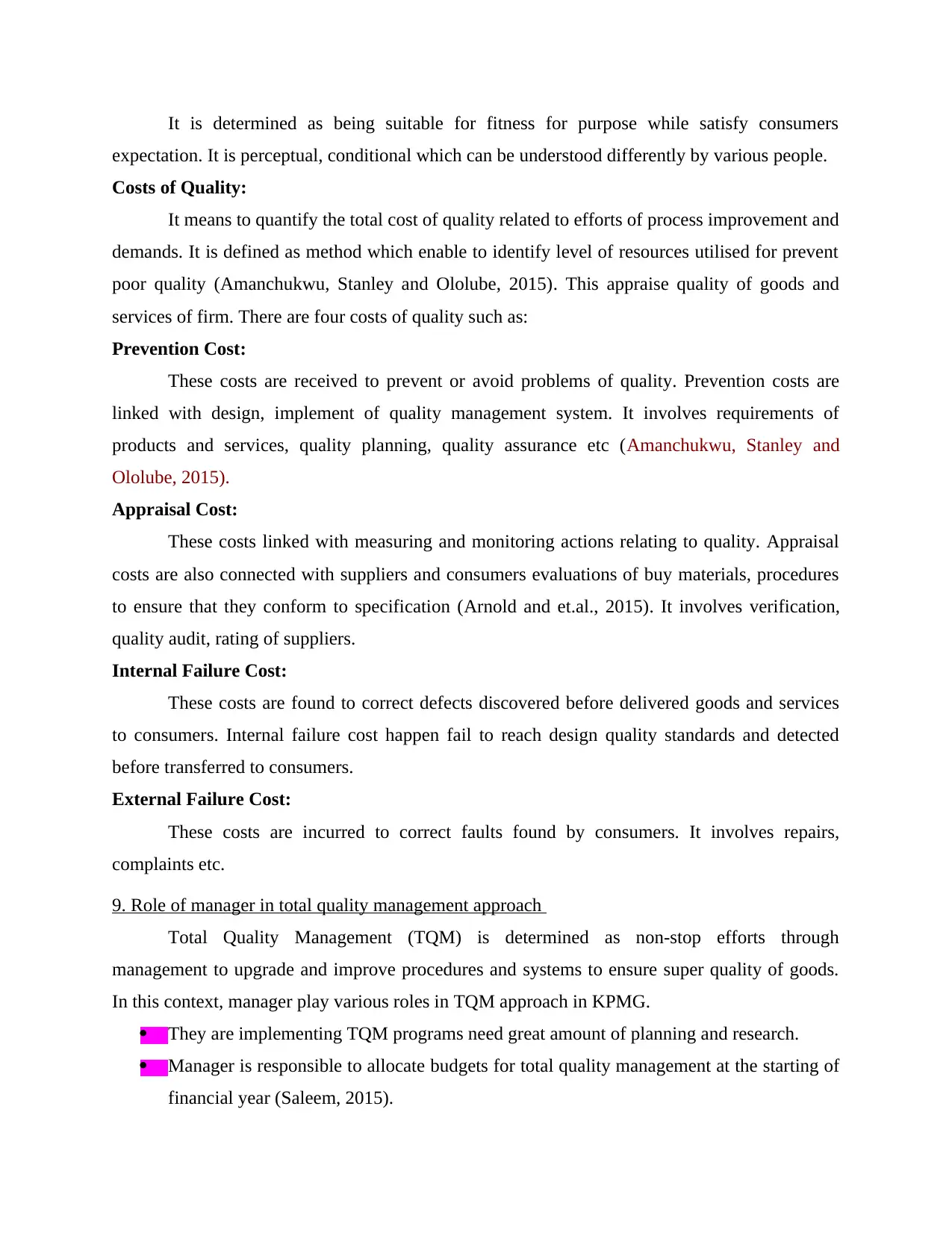
It is determined as being suitable for fitness for purpose while satisfy consumers
expectation. It is perceptual, conditional which can be understood differently by various people.
Costs of Quality:
It means to quantify the total cost of quality related to efforts of process improvement and
demands. It is defined as method which enable to identify level of resources utilised for prevent
poor quality (Amanchukwu, Stanley and Ololube, 2015). This appraise quality of goods and
services of firm. There are four costs of quality such as:
Prevention Cost:
These costs are received to prevent or avoid problems of quality. Prevention costs are
linked with design, implement of quality management system. It involves requirements of
products and services, quality planning, quality assurance etc (Amanchukwu, Stanley and
Ololube, 2015).
Appraisal Cost:
These costs linked with measuring and monitoring actions relating to quality. Appraisal
costs are also connected with suppliers and consumers evaluations of buy materials, procedures
to ensure that they conform to specification (Arnold and et.al., 2015). It involves verification,
quality audit, rating of suppliers.
Internal Failure Cost:
These costs are found to correct defects discovered before delivered goods and services
to consumers. Internal failure cost happen fail to reach design quality standards and detected
before transferred to consumers.
External Failure Cost:
These costs are incurred to correct faults found by consumers. It involves repairs,
complaints etc.
9. Role of manager in total quality management approach
Total Quality Management (TQM) is determined as non-stop efforts through
management to upgrade and improve procedures and systems to ensure super quality of goods.
In this context, manager play various roles in TQM approach in KPMG.
They are implementing TQM programs need great amount of planning and research.
Manager is responsible to allocate budgets for total quality management at the starting of
financial year (Saleem, 2015).
expectation. It is perceptual, conditional which can be understood differently by various people.
Costs of Quality:
It means to quantify the total cost of quality related to efforts of process improvement and
demands. It is defined as method which enable to identify level of resources utilised for prevent
poor quality (Amanchukwu, Stanley and Ololube, 2015). This appraise quality of goods and
services of firm. There are four costs of quality such as:
Prevention Cost:
These costs are received to prevent or avoid problems of quality. Prevention costs are
linked with design, implement of quality management system. It involves requirements of
products and services, quality planning, quality assurance etc (Amanchukwu, Stanley and
Ololube, 2015).
Appraisal Cost:
These costs linked with measuring and monitoring actions relating to quality. Appraisal
costs are also connected with suppliers and consumers evaluations of buy materials, procedures
to ensure that they conform to specification (Arnold and et.al., 2015). It involves verification,
quality audit, rating of suppliers.
Internal Failure Cost:
These costs are found to correct defects discovered before delivered goods and services
to consumers. Internal failure cost happen fail to reach design quality standards and detected
before transferred to consumers.
External Failure Cost:
These costs are incurred to correct faults found by consumers. It involves repairs,
complaints etc.
9. Role of manager in total quality management approach
Total Quality Management (TQM) is determined as non-stop efforts through
management to upgrade and improve procedures and systems to ensure super quality of goods.
In this context, manager play various roles in TQM approach in KPMG.
They are implementing TQM programs need great amount of planning and research.
Manager is responsible to allocate budgets for total quality management at the starting of
financial year (Saleem, 2015).

They play role as facilitator at the firm in relation to implement total quality
management.
It is the responsibility of manager to communicate benefits of TQM to all members of the
KPMG.
Manager play role to assign resources for total quality management and allocate time for
different training programs in the workplace (Boyabatlı, Nguyen and Wang, 2017).
10. Just-in-time approach and waste reduction in operations
Just-in-time Approach (JIT):
It is management strategy which align raw material orders from suppliers directly with
schedules of production. It is also known as just-in-time production that is method to reduce time
within operations system and response times from suppliers and consumers. The main direction
of JIT is to determine and correct obstacles in process of production (Boyabatlı, Nguyen and
Wang, 2017). This method prevents from utilizing excessive stock and production operations
smoothly. The aim of JIT is to raise turnover of inventory and decrease holding and all
associated cost.
Waste Reduction:
It is also known as waste minimization which is set of procedures and practices supposed
to decrease amount of waste produced. Waste reduction can protect the surrounding and turn out
positive economic benefits. It can improve production practices and economic returns. Waste
reduction can improve quality of produce goods and meet targets of environmental regulations
(Strande and Brdjanovic, eds., 2014). It can improve financial performance of firm while
decrease costs of buying new material. Waste reduction help to increase reputation of KPMG.
11. Three methods for capacity management
Capacity Management:
It refers to ability to meet requirements with the available resources such as labour,
machinery, raw material at hand. Time and capacity are two main constraints in capacity
management. There are various methods or strategies for capacity management within the
organization. Such as:
Adjusting equipment and process:
Manager can adjust capacity management by purchasing additional machinery, selling
and leasing out old equipment in the organization. Therefore, manager needs to adjust the all
management.
It is the responsibility of manager to communicate benefits of TQM to all members of the
KPMG.
Manager play role to assign resources for total quality management and allocate time for
different training programs in the workplace (Boyabatlı, Nguyen and Wang, 2017).
10. Just-in-time approach and waste reduction in operations
Just-in-time Approach (JIT):
It is management strategy which align raw material orders from suppliers directly with
schedules of production. It is also known as just-in-time production that is method to reduce time
within operations system and response times from suppliers and consumers. The main direction
of JIT is to determine and correct obstacles in process of production (Boyabatlı, Nguyen and
Wang, 2017). This method prevents from utilizing excessive stock and production operations
smoothly. The aim of JIT is to raise turnover of inventory and decrease holding and all
associated cost.
Waste Reduction:
It is also known as waste minimization which is set of procedures and practices supposed
to decrease amount of waste produced. Waste reduction can protect the surrounding and turn out
positive economic benefits. It can improve production practices and economic returns. Waste
reduction can improve quality of produce goods and meet targets of environmental regulations
(Strande and Brdjanovic, eds., 2014). It can improve financial performance of firm while
decrease costs of buying new material. Waste reduction help to increase reputation of KPMG.
11. Three methods for capacity management
Capacity Management:
It refers to ability to meet requirements with the available resources such as labour,
machinery, raw material at hand. Time and capacity are two main constraints in capacity
management. There are various methods or strategies for capacity management within the
organization. Such as:
Adjusting equipment and process:
Manager can adjust capacity management by purchasing additional machinery, selling
and leasing out old equipment in the organization. Therefore, manager needs to adjust the all
Secure Best Marks with AI Grader
Need help grading? Try our AI Grader for instant feedback on your assignments.
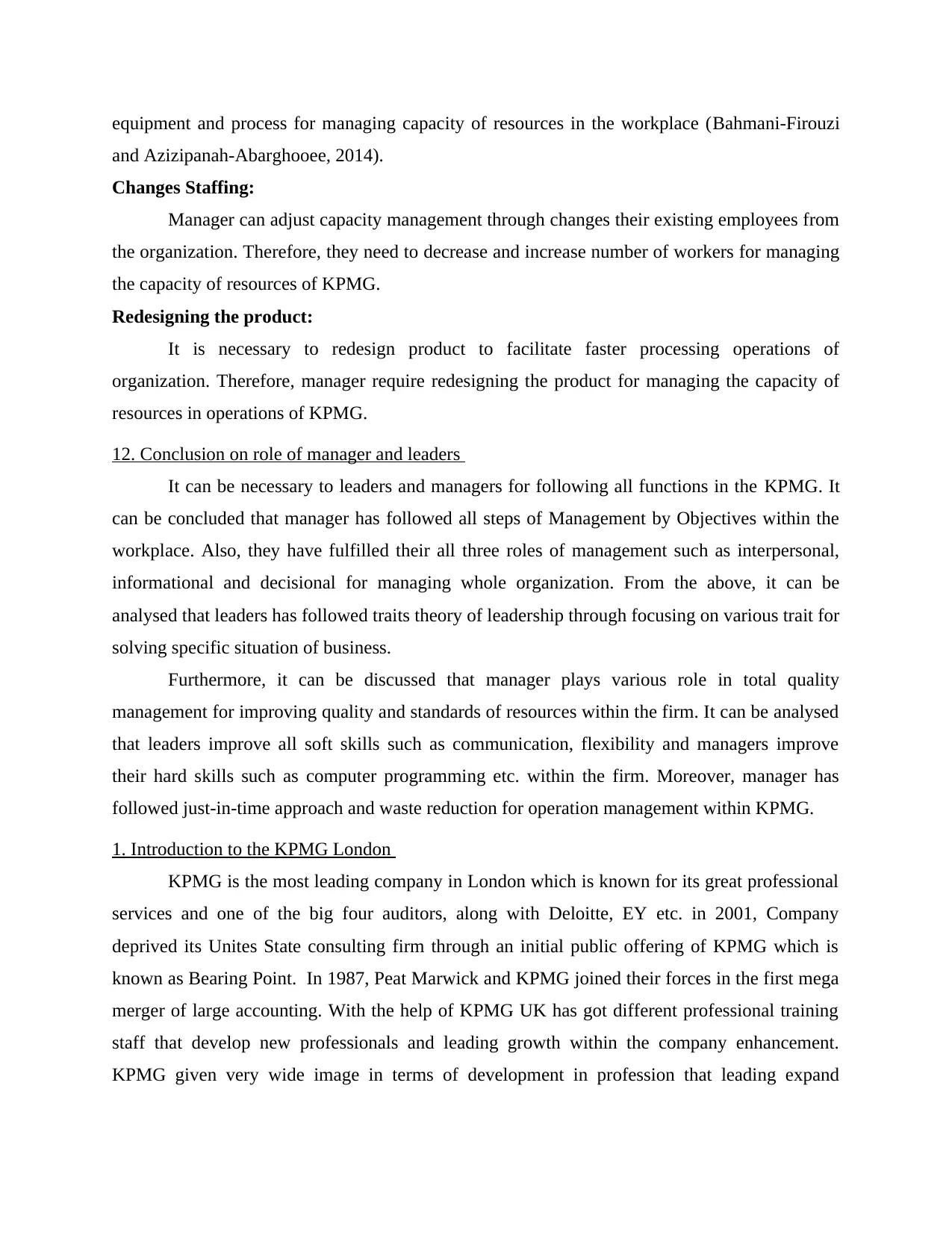
equipment and process for managing capacity of resources in the workplace (Bahmani-Firouzi
and Azizipanah-Abarghooee, 2014).
Changes Staffing:
Manager can adjust capacity management through changes their existing employees from
the organization. Therefore, they need to decrease and increase number of workers for managing
the capacity of resources of KPMG.
Redesigning the product:
It is necessary to redesign product to facilitate faster processing operations of
organization. Therefore, manager require redesigning the product for managing the capacity of
resources in operations of KPMG.
12. Conclusion on role of manager and leaders
It can be necessary to leaders and managers for following all functions in the KPMG. It
can be concluded that manager has followed all steps of Management by Objectives within the
workplace. Also, they have fulfilled their all three roles of management such as interpersonal,
informational and decisional for managing whole organization. From the above, it can be
analysed that leaders has followed traits theory of leadership through focusing on various trait for
solving specific situation of business.
Furthermore, it can be discussed that manager plays various role in total quality
management for improving quality and standards of resources within the firm. It can be analysed
that leaders improve all soft skills such as communication, flexibility and managers improve
their hard skills such as computer programming etc. within the firm. Moreover, manager has
followed just-in-time approach and waste reduction for operation management within KPMG.
1. Introduction to the KPMG London
KPMG is the most leading company in London which is known for its great professional
services and one of the big four auditors, along with Deloitte, EY etc. in 2001, Company
deprived its Unites State consulting firm through an initial public offering of KPMG which is
known as Bearing Point. In 1987, Peat Marwick and KPMG joined their forces in the first mega
merger of large accounting. With the help of KPMG UK has got different professional training
staff that develop new professionals and leading growth within the company enhancement.
KPMG given very wide image in terms of development in profession that leading expand
and Azizipanah-Abarghooee, 2014).
Changes Staffing:
Manager can adjust capacity management through changes their existing employees from
the organization. Therefore, they need to decrease and increase number of workers for managing
the capacity of resources of KPMG.
Redesigning the product:
It is necessary to redesign product to facilitate faster processing operations of
organization. Therefore, manager require redesigning the product for managing the capacity of
resources in operations of KPMG.
12. Conclusion on role of manager and leaders
It can be necessary to leaders and managers for following all functions in the KPMG. It
can be concluded that manager has followed all steps of Management by Objectives within the
workplace. Also, they have fulfilled their all three roles of management such as interpersonal,
informational and decisional for managing whole organization. From the above, it can be
analysed that leaders has followed traits theory of leadership through focusing on various trait for
solving specific situation of business.
Furthermore, it can be discussed that manager plays various role in total quality
management for improving quality and standards of resources within the firm. It can be analysed
that leaders improve all soft skills such as communication, flexibility and managers improve
their hard skills such as computer programming etc. within the firm. Moreover, manager has
followed just-in-time approach and waste reduction for operation management within KPMG.
1. Introduction to the KPMG London
KPMG is the most leading company in London which is known for its great professional
services and one of the big four auditors, along with Deloitte, EY etc. in 2001, Company
deprived its Unites State consulting firm through an initial public offering of KPMG which is
known as Bearing Point. In 1987, Peat Marwick and KPMG joined their forces in the first mega
merger of large accounting. With the help of KPMG UK has got different professional training
staff that develop new professionals and leading growth within the company enhancement.
KPMG given very wide image in terms of development in profession that leading expand

effective growth. They provide fresh and talented staff and maintained performance after Brexit
effects.
Basically, KPMG deals with Audit Tax, Pensions and legal, Deal Advisory and
Consulting with high potential growth. KPMG fulfil the client generic needs so that they can
fully trust on the company services.
2. Explanation of the department including the role in operations.
Operation department is the most important department within the organisations in order to
accomplish the company set standards and growth. Operation department is branch of managing
operations within the organisations. With the help of operation support, company can easily get
the excellent result outcomes. Operation manager needs to overlook on the day to day activities
through they can easily meet out the day to day task (Mendis, Muttaqi and Perera, 2014).
Another roles and responsibilities of operation manager are to manage resources,
financial management, Goal-setting, communication at all departments etc. the main concerned
of operation department is required equipment, manageable resources such as finance, human
resources, technological source etc. for working in operation department, employees should have
the power of understanding of various processes within a company. Apart from that,
responsibilities of managers or employees working as a management team. They required
adopting accountability of different roles and responsibilities. Overall, it helps to make the long
term effective working outcomes and growth to build new developing results (Boyabatlı,
Nguyen and Wang, 2017).
3. Management team in department
Operation department of KPMG is responsible for producing the services and providing
those services to consumers directly. Operation managers working with management team for
making the decisions relating to production and consumption of an intangible good. These
decisions concern process, people, information and system which produce and deliver the
services to customers (Qu, Janssen and Shi, 2015). Management team of operation department
performs different activities such as quality management, capacity management, scheduling,
stock, supply chain of services and information technology. Therefore, all team members of
operation department follow all processes and methods for effective operations of business. In
this context, effective operations help to increase profits and gain competitive advantages of the
effects.
Basically, KPMG deals with Audit Tax, Pensions and legal, Deal Advisory and
Consulting with high potential growth. KPMG fulfil the client generic needs so that they can
fully trust on the company services.
2. Explanation of the department including the role in operations.
Operation department is the most important department within the organisations in order to
accomplish the company set standards and growth. Operation department is branch of managing
operations within the organisations. With the help of operation support, company can easily get
the excellent result outcomes. Operation manager needs to overlook on the day to day activities
through they can easily meet out the day to day task (Mendis, Muttaqi and Perera, 2014).
Another roles and responsibilities of operation manager are to manage resources,
financial management, Goal-setting, communication at all departments etc. the main concerned
of operation department is required equipment, manageable resources such as finance, human
resources, technological source etc. for working in operation department, employees should have
the power of understanding of various processes within a company. Apart from that,
responsibilities of managers or employees working as a management team. They required
adopting accountability of different roles and responsibilities. Overall, it helps to make the long
term effective working outcomes and growth to build new developing results (Boyabatlı,
Nguyen and Wang, 2017).
3. Management team in department
Operation department of KPMG is responsible for producing the services and providing
those services to consumers directly. Operation managers working with management team for
making the decisions relating to production and consumption of an intangible good. These
decisions concern process, people, information and system which produce and deliver the
services to customers (Qu, Janssen and Shi, 2015). Management team of operation department
performs different activities such as quality management, capacity management, scheduling,
stock, supply chain of services and information technology. Therefore, all team members of
operation department follow all processes and methods for effective operations of business. In
this context, effective operations help to increase profits and gain competitive advantages of the
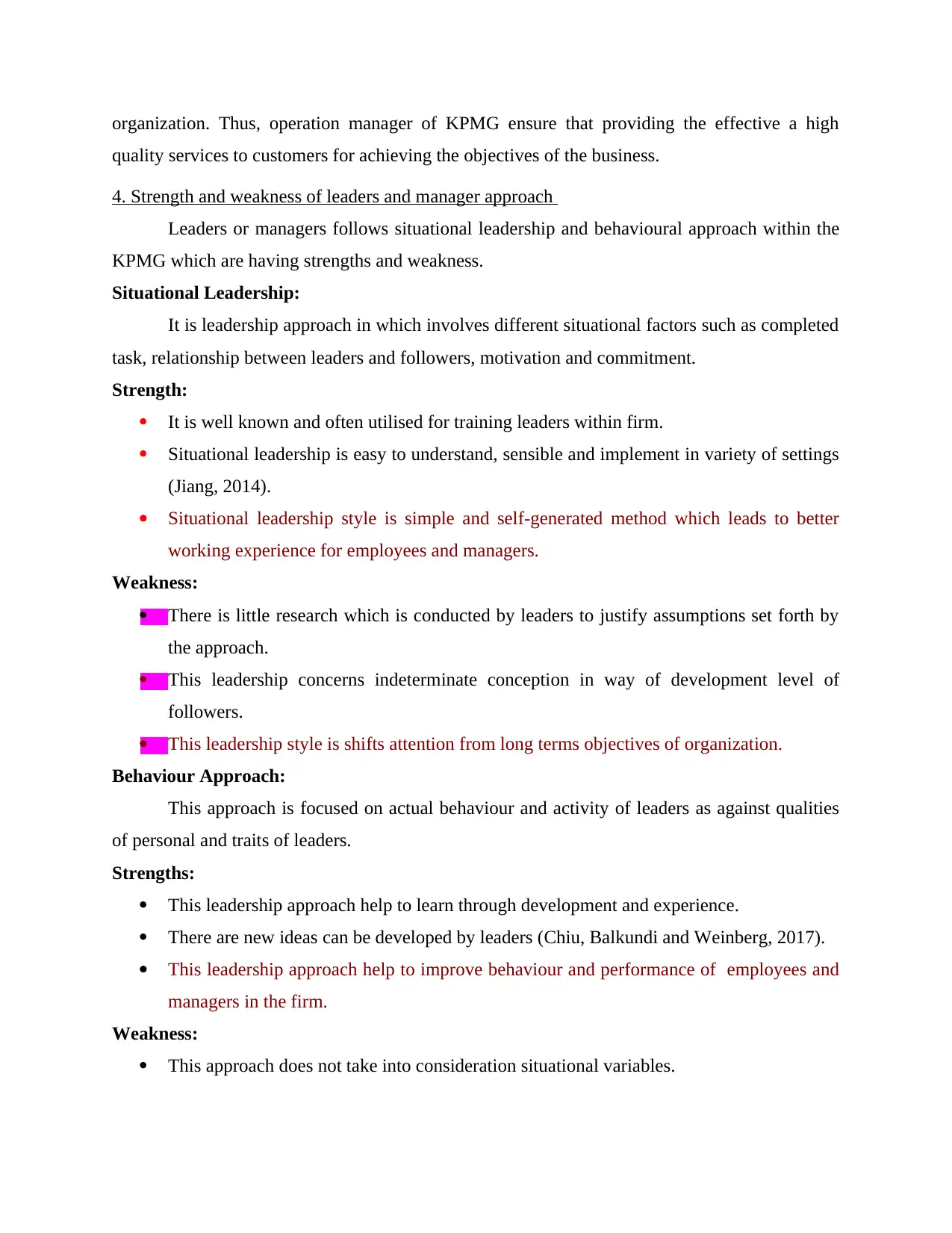
organization. Thus, operation manager of KPMG ensure that providing the effective a high
quality services to customers for achieving the objectives of the business.
4. Strength and weakness of leaders and manager approach
Leaders or managers follows situational leadership and behavioural approach within the
KPMG which are having strengths and weakness.
Situational Leadership:
It is leadership approach in which involves different situational factors such as completed
task, relationship between leaders and followers, motivation and commitment.
Strength:
It is well known and often utilised for training leaders within firm.
Situational leadership is easy to understand, sensible and implement in variety of settings
(Jiang, 2014).
Situational leadership style is simple and self-generated method which leads to better
working experience for employees and managers.
Weakness:
There is little research which is conducted by leaders to justify assumptions set forth by
the approach.
This leadership concerns indeterminate conception in way of development level of
followers.
This leadership style is shifts attention from long terms objectives of organization.
Behaviour Approach:
This approach is focused on actual behaviour and activity of leaders as against qualities
of personal and traits of leaders.
Strengths:
This leadership approach help to learn through development and experience.
There are new ideas can be developed by leaders (Chiu, Balkundi and Weinberg, 2017).
This leadership approach help to improve behaviour and performance of employees and
managers in the firm.
Weakness:
This approach does not take into consideration situational variables.
quality services to customers for achieving the objectives of the business.
4. Strength and weakness of leaders and manager approach
Leaders or managers follows situational leadership and behavioural approach within the
KPMG which are having strengths and weakness.
Situational Leadership:
It is leadership approach in which involves different situational factors such as completed
task, relationship between leaders and followers, motivation and commitment.
Strength:
It is well known and often utilised for training leaders within firm.
Situational leadership is easy to understand, sensible and implement in variety of settings
(Jiang, 2014).
Situational leadership style is simple and self-generated method which leads to better
working experience for employees and managers.
Weakness:
There is little research which is conducted by leaders to justify assumptions set forth by
the approach.
This leadership concerns indeterminate conception in way of development level of
followers.
This leadership style is shifts attention from long terms objectives of organization.
Behaviour Approach:
This approach is focused on actual behaviour and activity of leaders as against qualities
of personal and traits of leaders.
Strengths:
This leadership approach help to learn through development and experience.
There are new ideas can be developed by leaders (Chiu, Balkundi and Weinberg, 2017).
This leadership approach help to improve behaviour and performance of employees and
managers in the firm.
Weakness:
This approach does not take into consideration situational variables.
Paraphrase This Document
Need a fresh take? Get an instant paraphrase of this document with our AI Paraphraser

There is lack of knowledge on this approach which can be utilised in different culture
context.
5. Roles and duties of management in organization
Management plays various roles within the KPMG.
Interpersonal Role-figurehead, leaders and Liaisons.
Informational Role-monitor, disseminator and spokesperson.
Decisional Role-entrepreneur, disturbance handler, resources allocators, negotiator.
6. Provide real occasion and apply theories and role of management
Management plays essential role for solving the situations regrading employees,
consumers, supply etc. They also follow different methods and approach to solve problems
effectively within the organization.
For example: KPMG face situation relating quality and standards of services which is
provided to consumers by firm. Therefore, management plays role decisional role as disturbance
handler for solving this situation. In this context, they are followed different techniques and
strategies to solve the situation (Huang and Feeney, 2016). They giving the best training and
development to employees for improving quality of services and providing to consumers
effectively. Also, management set standards and monitor quality of services to consumers.
Therefore, manager follow total quality management approach for improving the quality
of services of company. With the help of it, increase profits and gain competitive advantages. In
this context, manager make sure that setting standard and quality improvement of services within
the firm. With the help of effective management, improving the quality and impressive
operations of firm.
7. Leadership style applied in this situation
Leaders also play important role and contributing in solving the situation within the
KPMG. Also, leader give the guidance and effective training and development to employees, so
that workers are easily contributed in solving the situation that is quality and standard of services
to organization. Therefore, leader adopt democratic leadership style in which they are
encouraged for participation, exchange ideas and opinion in decision making process as well as
solve situation in the workplace (Nanjundeswaraswamy and Swamy, 2014).
context.
5. Roles and duties of management in organization
Management plays various roles within the KPMG.
Interpersonal Role-figurehead, leaders and Liaisons.
Informational Role-monitor, disseminator and spokesperson.
Decisional Role-entrepreneur, disturbance handler, resources allocators, negotiator.
6. Provide real occasion and apply theories and role of management
Management plays essential role for solving the situations regrading employees,
consumers, supply etc. They also follow different methods and approach to solve problems
effectively within the organization.
For example: KPMG face situation relating quality and standards of services which is
provided to consumers by firm. Therefore, management plays role decisional role as disturbance
handler for solving this situation. In this context, they are followed different techniques and
strategies to solve the situation (Huang and Feeney, 2016). They giving the best training and
development to employees for improving quality of services and providing to consumers
effectively. Also, management set standards and monitor quality of services to consumers.
Therefore, manager follow total quality management approach for improving the quality
of services of company. With the help of it, increase profits and gain competitive advantages. In
this context, manager make sure that setting standard and quality improvement of services within
the firm. With the help of effective management, improving the quality and impressive
operations of firm.
7. Leadership style applied in this situation
Leaders also play important role and contributing in solving the situation within the
KPMG. Also, leader give the guidance and effective training and development to employees, so
that workers are easily contributed in solving the situation that is quality and standard of services
to organization. Therefore, leader adopt democratic leadership style in which they are
encouraged for participation, exchange ideas and opinion in decision making process as well as
solve situation in the workplace (Nanjundeswaraswamy and Swamy, 2014).
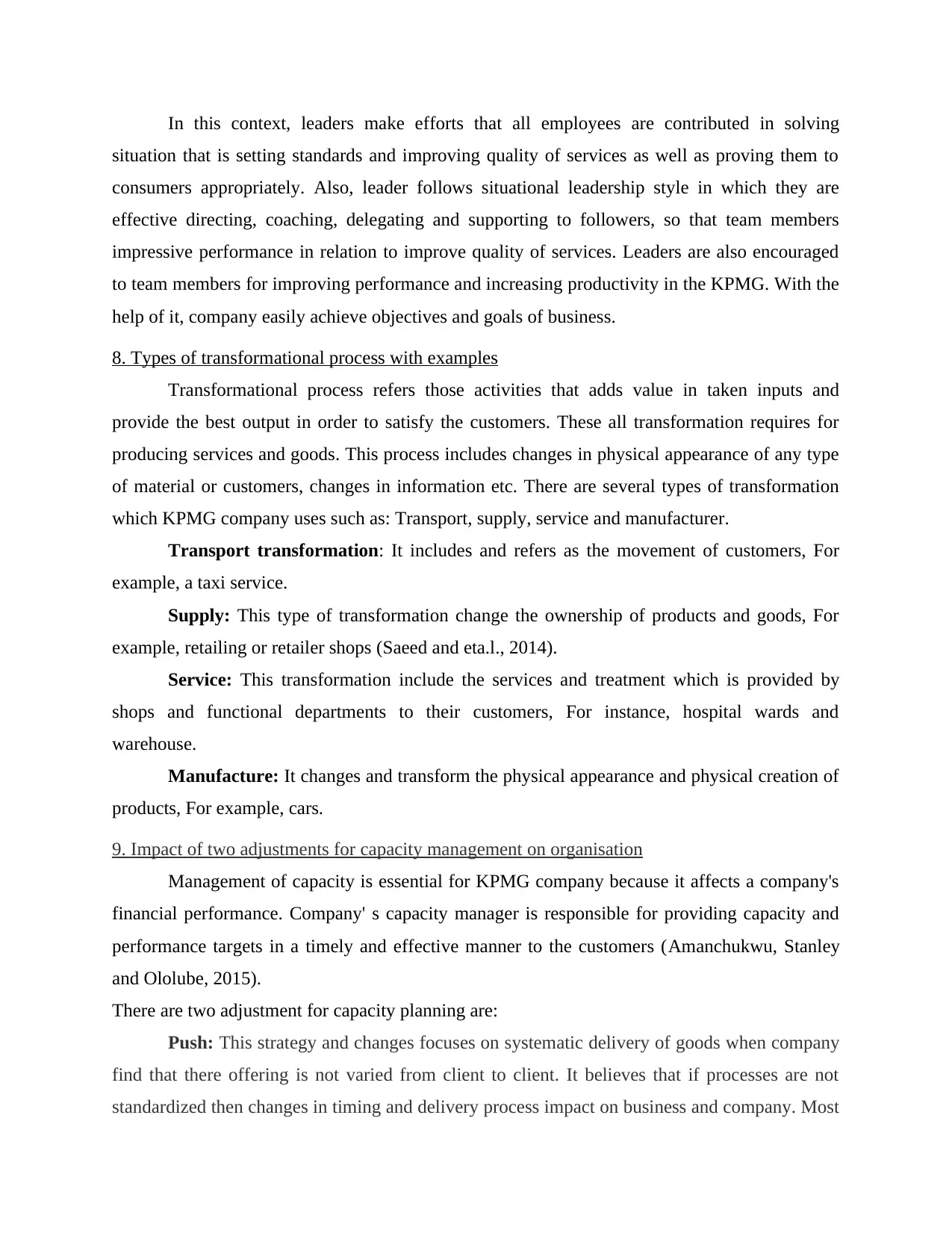
In this context, leaders make efforts that all employees are contributed in solving
situation that is setting standards and improving quality of services as well as proving them to
consumers appropriately. Also, leader follows situational leadership style in which they are
effective directing, coaching, delegating and supporting to followers, so that team members
impressive performance in relation to improve quality of services. Leaders are also encouraged
to team members for improving performance and increasing productivity in the KPMG. With the
help of it, company easily achieve objectives and goals of business.
8. Types of transformational process with examples
Transformational process refers those activities that adds value in taken inputs and
provide the best output in order to satisfy the customers. These all transformation requires for
producing services and goods. This process includes changes in physical appearance of any type
of material or customers, changes in information etc. There are several types of transformation
which KPMG company uses such as: Transport, supply, service and manufacturer.
Transport transformation: It includes and refers as the movement of customers, For
example, a taxi service.
Supply: This type of transformation change the ownership of products and goods, For
example, retailing or retailer shops (Saeed and eta.l., 2014).
Service: This transformation include the services and treatment which is provided by
shops and functional departments to their customers, For instance, hospital wards and
warehouse.
Manufacture: It changes and transform the physical appearance and physical creation of
products, For example, cars.
9. Impact of two adjustments for capacity management on organisation
Management of capacity is essential for KPMG company because it affects a company's
financial performance. Company' s capacity manager is responsible for providing capacity and
performance targets in a timely and effective manner to the customers (Amanchukwu, Stanley
and Ololube, 2015).
There are two adjustment for capacity planning are:
Push: This strategy and changes focuses on systematic delivery of goods when company
find that there offering is not varied from client to client. It believes that if processes are not
standardized then changes in timing and delivery process impact on business and company. Most
situation that is setting standards and improving quality of services as well as proving them to
consumers appropriately. Also, leader follows situational leadership style in which they are
effective directing, coaching, delegating and supporting to followers, so that team members
impressive performance in relation to improve quality of services. Leaders are also encouraged
to team members for improving performance and increasing productivity in the KPMG. With the
help of it, company easily achieve objectives and goals of business.
8. Types of transformational process with examples
Transformational process refers those activities that adds value in taken inputs and
provide the best output in order to satisfy the customers. These all transformation requires for
producing services and goods. This process includes changes in physical appearance of any type
of material or customers, changes in information etc. There are several types of transformation
which KPMG company uses such as: Transport, supply, service and manufacturer.
Transport transformation: It includes and refers as the movement of customers, For
example, a taxi service.
Supply: This type of transformation change the ownership of products and goods, For
example, retailing or retailer shops (Saeed and eta.l., 2014).
Service: This transformation include the services and treatment which is provided by
shops and functional departments to their customers, For instance, hospital wards and
warehouse.
Manufacture: It changes and transform the physical appearance and physical creation of
products, For example, cars.
9. Impact of two adjustments for capacity management on organisation
Management of capacity is essential for KPMG company because it affects a company's
financial performance. Company' s capacity manager is responsible for providing capacity and
performance targets in a timely and effective manner to the customers (Amanchukwu, Stanley
and Ololube, 2015).
There are two adjustment for capacity planning are:
Push: This strategy and changes focuses on systematic delivery of goods when company
find that there offering is not varied from client to client. It believes that if processes are not
standardized then changes in timing and delivery process impact on business and company. Most
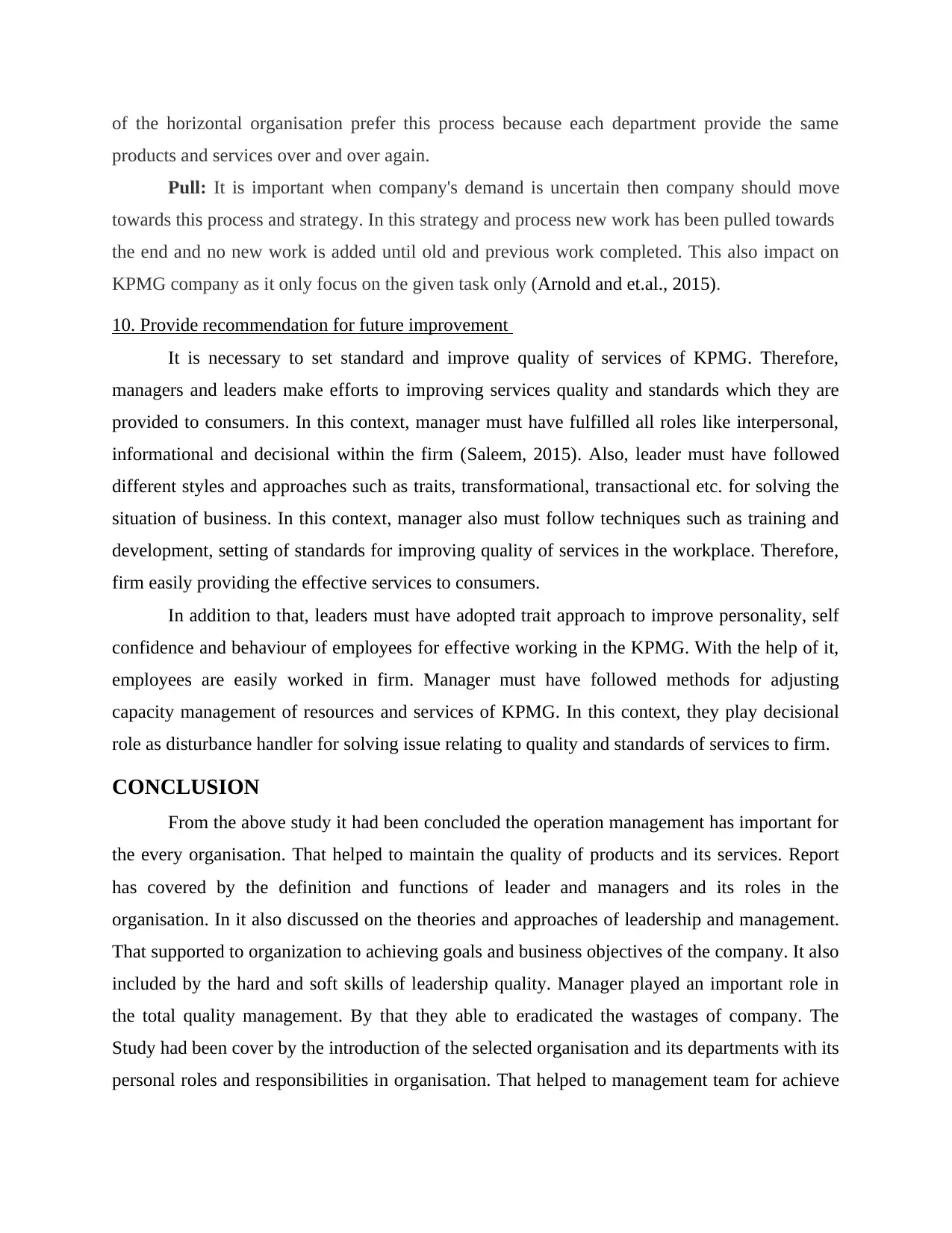
of the horizontal organisation prefer this process because each department provide the same
products and services over and over again.
Pull: It is important when company's demand is uncertain then company should move
towards this process and strategy. In this strategy and process new work has been pulled towards
the end and no new work is added until old and previous work completed. This also impact on
KPMG company as it only focus on the given task only (Arnold and et.al., 2015).
10. Provide recommendation for future improvement
It is necessary to set standard and improve quality of services of KPMG. Therefore,
managers and leaders make efforts to improving services quality and standards which they are
provided to consumers. In this context, manager must have fulfilled all roles like interpersonal,
informational and decisional within the firm (Saleem, 2015). Also, leader must have followed
different styles and approaches such as traits, transformational, transactional etc. for solving the
situation of business. In this context, manager also must follow techniques such as training and
development, setting of standards for improving quality of services in the workplace. Therefore,
firm easily providing the effective services to consumers.
In addition to that, leaders must have adopted trait approach to improve personality, self
confidence and behaviour of employees for effective working in the KPMG. With the help of it,
employees are easily worked in firm. Manager must have followed methods for adjusting
capacity management of resources and services of KPMG. In this context, they play decisional
role as disturbance handler for solving issue relating to quality and standards of services to firm.
CONCLUSION
From the above study it had been concluded the operation management has important for
the every organisation. That helped to maintain the quality of products and its services. Report
has covered by the definition and functions of leader and managers and its roles in the
organisation. In it also discussed on the theories and approaches of leadership and management.
That supported to organization to achieving goals and business objectives of the company. It also
included by the hard and soft skills of leadership quality. Manager played an important role in
the total quality management. By that they able to eradicated the wastages of company. The
Study had been cover by the introduction of the selected organisation and its departments with its
personal roles and responsibilities in organisation. That helped to management team for achieve
products and services over and over again.
Pull: It is important when company's demand is uncertain then company should move
towards this process and strategy. In this strategy and process new work has been pulled towards
the end and no new work is added until old and previous work completed. This also impact on
KPMG company as it only focus on the given task only (Arnold and et.al., 2015).
10. Provide recommendation for future improvement
It is necessary to set standard and improve quality of services of KPMG. Therefore,
managers and leaders make efforts to improving services quality and standards which they are
provided to consumers. In this context, manager must have fulfilled all roles like interpersonal,
informational and decisional within the firm (Saleem, 2015). Also, leader must have followed
different styles and approaches such as traits, transformational, transactional etc. for solving the
situation of business. In this context, manager also must follow techniques such as training and
development, setting of standards for improving quality of services in the workplace. Therefore,
firm easily providing the effective services to consumers.
In addition to that, leaders must have adopted trait approach to improve personality, self
confidence and behaviour of employees for effective working in the KPMG. With the help of it,
employees are easily worked in firm. Manager must have followed methods for adjusting
capacity management of resources and services of KPMG. In this context, they play decisional
role as disturbance handler for solving issue relating to quality and standards of services to firm.
CONCLUSION
From the above study it had been concluded the operation management has important for
the every organisation. That helped to maintain the quality of products and its services. Report
has covered by the definition and functions of leader and managers and its roles in the
organisation. In it also discussed on the theories and approaches of leadership and management.
That supported to organization to achieving goals and business objectives of the company. It also
included by the hard and soft skills of leadership quality. Manager played an important role in
the total quality management. By that they able to eradicated the wastages of company. The
Study had been cover by the introduction of the selected organisation and its departments with its
personal roles and responsibilities in organisation. That helped to management team for achieve
Secure Best Marks with AI Grader
Need help grading? Try our AI Grader for instant feedback on your assignments.
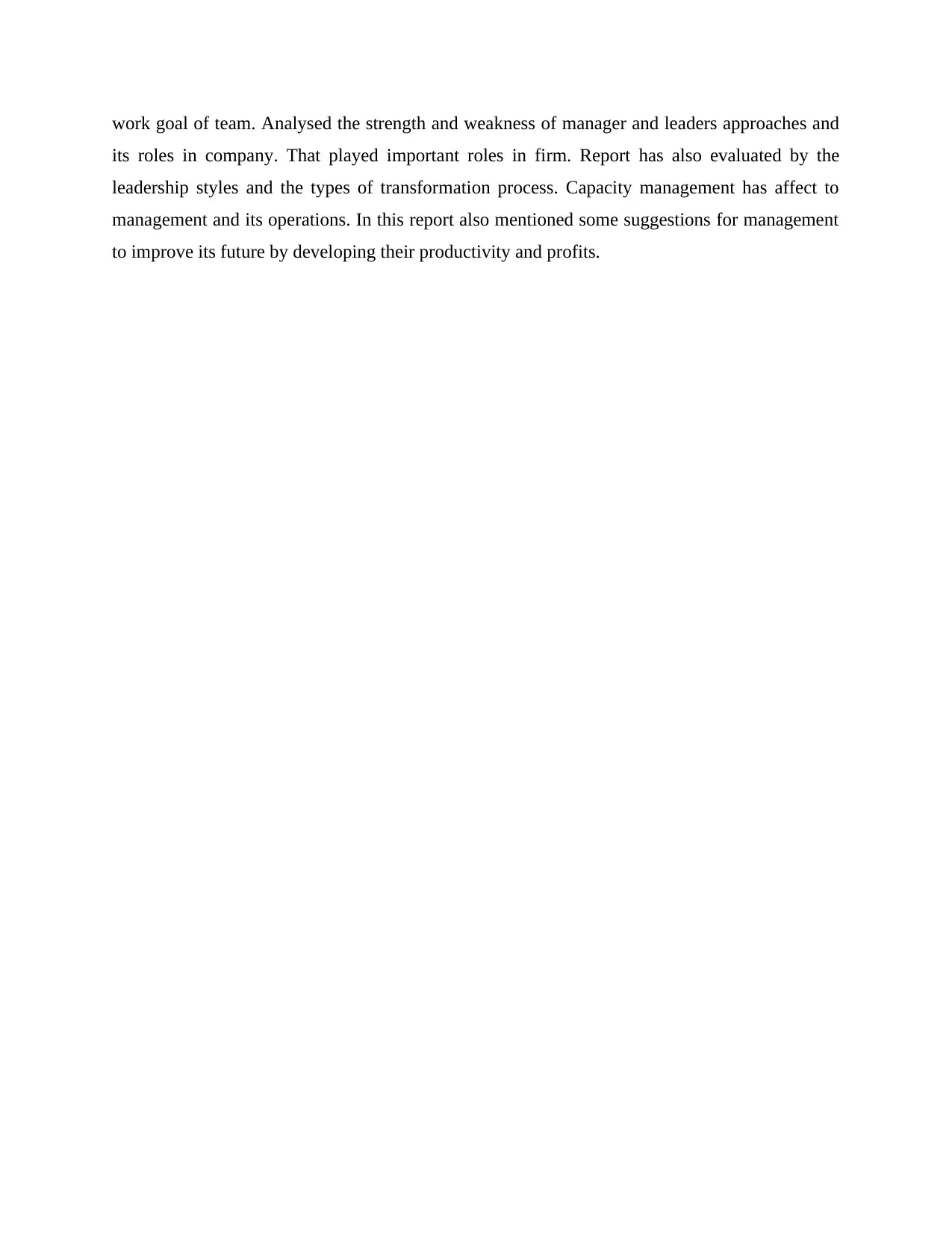
work goal of team. Analysed the strength and weakness of manager and leaders approaches and
its roles in company. That played important roles in firm. Report has also evaluated by the
leadership styles and the types of transformation process. Capacity management has affect to
management and its operations. In this report also mentioned some suggestions for management
to improve its future by developing their productivity and profits.
its roles in company. That played important roles in firm. Report has also evaluated by the
leadership styles and the types of transformation process. Capacity management has affect to
management and its operations. In this report also mentioned some suggestions for management
to improve its future by developing their productivity and profits.

REFERENCES
Books and Journals
Amanchukwu, R. N., Stanley, G. J. and Ololube, N. P., 2015. A review of leadership theories,
principles and styles and their relevance to educational management. Management. 5(1).
pp.6-14.
Arnold, K. A. and et.al., 2015. Leadership styles, emotion regulation, and burnout. Journal of
Occupational Health Psychology. 20(4). p.481.
Bahmani-Firouzi, B. and Azizipanah-Abarghooee, R., 2014. Optimal sizing of battery energy
storage for micro-grid operation management using a new improved bat
algorithm. International Journal of Electrical Power & Energy Systems. 56. pp.42-54.
Boyabatlı, O., Nguyen, J. and Wang, T., 2017. Capacity management in agricultural commodity
processing and application in the palm industry. Manufacturing & Service Operations
Management. 19(4). pp.551-567.
Chiu, C. Y. C., Balkundi, P. and Weinberg, F.J., 2017. When managers become leaders: The role
of manager network centralities, social power, and followers' perception of
leadership. The Leadership Quarterly. 28(2). pp.334-348.
Huang, T. and Liu, Q., 2015. Strategic capacity management when customers have boundedly
rational expectations. Production and Operations Management. 24(12). pp.1852-1869.
Huang, W. L. and Feeney, M. K., 2016. Citizen participation in local government decision
making: the role of manager motivation. Review of Public Personnel
Administration. 36(2). pp.188-209.
Jiang, J. Y., 2014. Leader–member relationship and burnout: The moderating role of leader
integrity. Management and Organization Review. 10(2). pp.223-247.
Mendis, N., Muttaqi, K. M. and Perera, S., 2014. Management of battery-supercapacitor hybrid
energy storage and synchronous condenser for isolated operation of PMSG based
variable-speed wind turbine generating systems. IEEE Transactions on smart grid. 5(2).
pp.944-953.
Nanjundeswaraswamy, T. S. and Swamy, D. R., 2014. Leadership styles. Advances in
management. 7(2). p.57.
Books and Journals
Amanchukwu, R. N., Stanley, G. J. and Ololube, N. P., 2015. A review of leadership theories,
principles and styles and their relevance to educational management. Management. 5(1).
pp.6-14.
Arnold, K. A. and et.al., 2015. Leadership styles, emotion regulation, and burnout. Journal of
Occupational Health Psychology. 20(4). p.481.
Bahmani-Firouzi, B. and Azizipanah-Abarghooee, R., 2014. Optimal sizing of battery energy
storage for micro-grid operation management using a new improved bat
algorithm. International Journal of Electrical Power & Energy Systems. 56. pp.42-54.
Boyabatlı, O., Nguyen, J. and Wang, T., 2017. Capacity management in agricultural commodity
processing and application in the palm industry. Manufacturing & Service Operations
Management. 19(4). pp.551-567.
Chiu, C. Y. C., Balkundi, P. and Weinberg, F.J., 2017. When managers become leaders: The role
of manager network centralities, social power, and followers' perception of
leadership. The Leadership Quarterly. 28(2). pp.334-348.
Huang, T. and Liu, Q., 2015. Strategic capacity management when customers have boundedly
rational expectations. Production and Operations Management. 24(12). pp.1852-1869.
Huang, W. L. and Feeney, M. K., 2016. Citizen participation in local government decision
making: the role of manager motivation. Review of Public Personnel
Administration. 36(2). pp.188-209.
Jiang, J. Y., 2014. Leader–member relationship and burnout: The moderating role of leader
integrity. Management and Organization Review. 10(2). pp.223-247.
Mendis, N., Muttaqi, K. M. and Perera, S., 2014. Management of battery-supercapacitor hybrid
energy storage and synchronous condenser for isolated operation of PMSG based
variable-speed wind turbine generating systems. IEEE Transactions on smart grid. 5(2).
pp.944-953.
Nanjundeswaraswamy, T. S. and Swamy, D. R., 2014. Leadership styles. Advances in
management. 7(2). p.57.
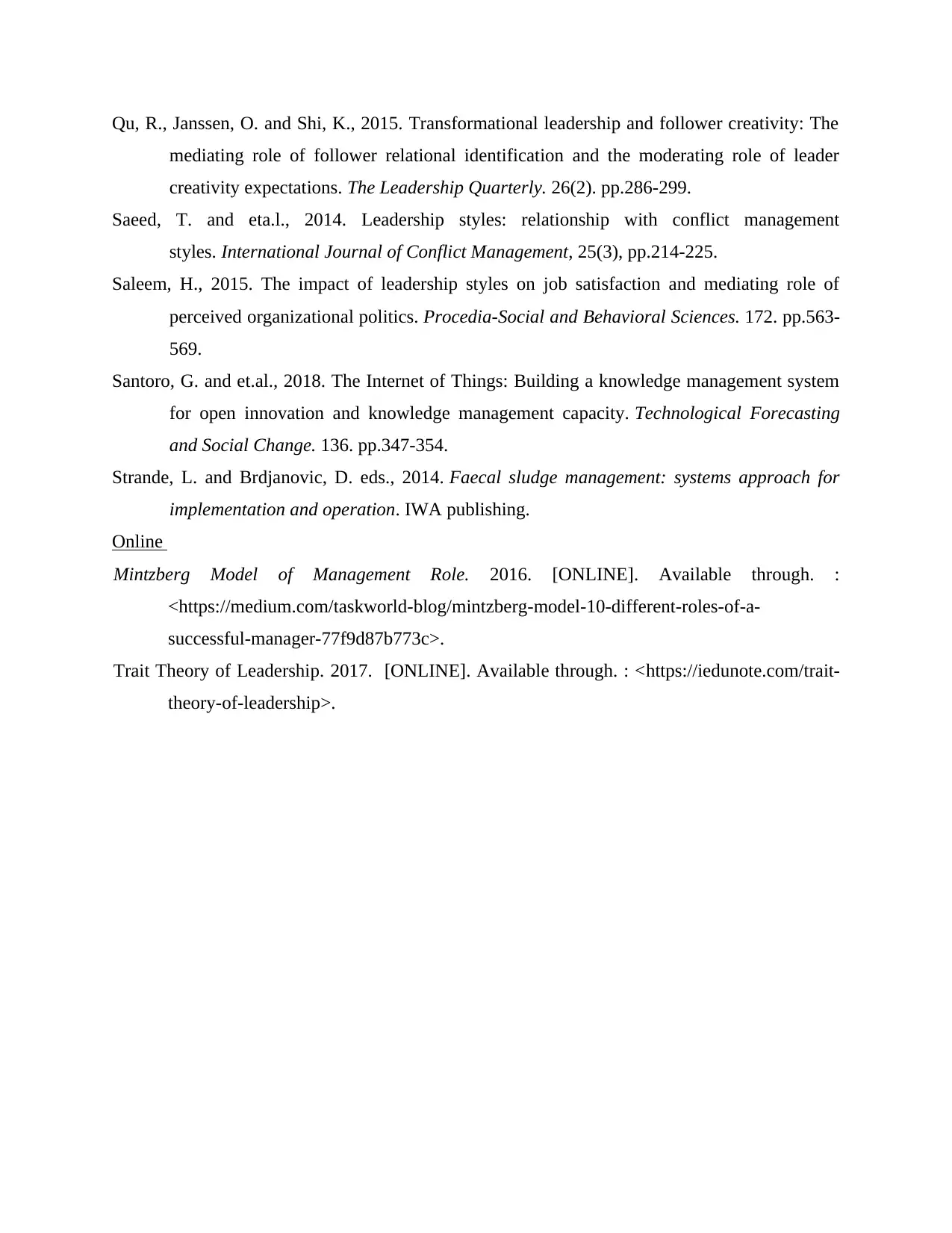
Qu, R., Janssen, O. and Shi, K., 2015. Transformational leadership and follower creativity: The
mediating role of follower relational identification and the moderating role of leader
creativity expectations. The Leadership Quarterly. 26(2). pp.286-299.
Saeed, T. and eta.l., 2014. Leadership styles: relationship with conflict management
styles. International Journal of Conflict Management, 25(3), pp.214-225.
Saleem, H., 2015. The impact of leadership styles on job satisfaction and mediating role of
perceived organizational politics. Procedia-Social and Behavioral Sciences. 172. pp.563-
569.
Santoro, G. and et.al., 2018. The Internet of Things: Building a knowledge management system
for open innovation and knowledge management capacity. Technological Forecasting
and Social Change. 136. pp.347-354.
Strande, L. and Brdjanovic, D. eds., 2014. Faecal sludge management: systems approach for
implementation and operation. IWA publishing.
Online
Mintzberg Model of Management Role. 2016. [ONLINE]. Available through. :
<https://medium.com/taskworld-blog/mintzberg-model-10-different-roles-of-a-
successful-manager-77f9d87b773c>.
Trait Theory of Leadership. 2017. [ONLINE]. Available through. : <https://iedunote.com/trait-
theory-of-leadership>.
mediating role of follower relational identification and the moderating role of leader
creativity expectations. The Leadership Quarterly. 26(2). pp.286-299.
Saeed, T. and eta.l., 2014. Leadership styles: relationship with conflict management
styles. International Journal of Conflict Management, 25(3), pp.214-225.
Saleem, H., 2015. The impact of leadership styles on job satisfaction and mediating role of
perceived organizational politics. Procedia-Social and Behavioral Sciences. 172. pp.563-
569.
Santoro, G. and et.al., 2018. The Internet of Things: Building a knowledge management system
for open innovation and knowledge management capacity. Technological Forecasting
and Social Change. 136. pp.347-354.
Strande, L. and Brdjanovic, D. eds., 2014. Faecal sludge management: systems approach for
implementation and operation. IWA publishing.
Online
Mintzberg Model of Management Role. 2016. [ONLINE]. Available through. :
<https://medium.com/taskworld-blog/mintzberg-model-10-different-roles-of-a-
successful-manager-77f9d87b773c>.
Trait Theory of Leadership. 2017. [ONLINE]. Available through. : <https://iedunote.com/trait-
theory-of-leadership>.
1 out of 19
Related Documents
Your All-in-One AI-Powered Toolkit for Academic Success.
+13062052269
info@desklib.com
Available 24*7 on WhatsApp / Email
![[object Object]](/_next/static/media/star-bottom.7253800d.svg)
Unlock your academic potential
© 2024 | Zucol Services PVT LTD | All rights reserved.





